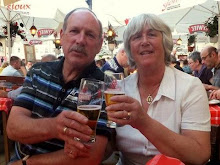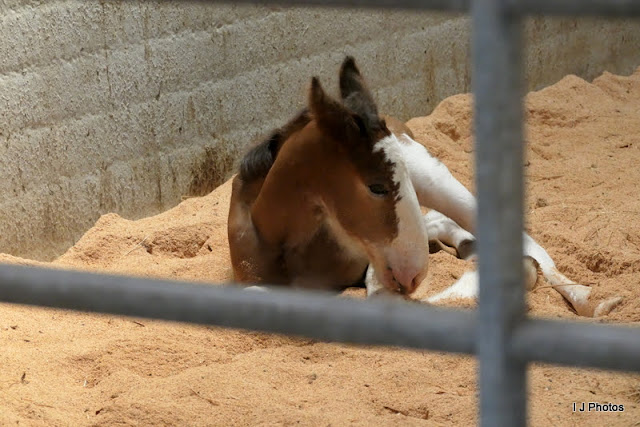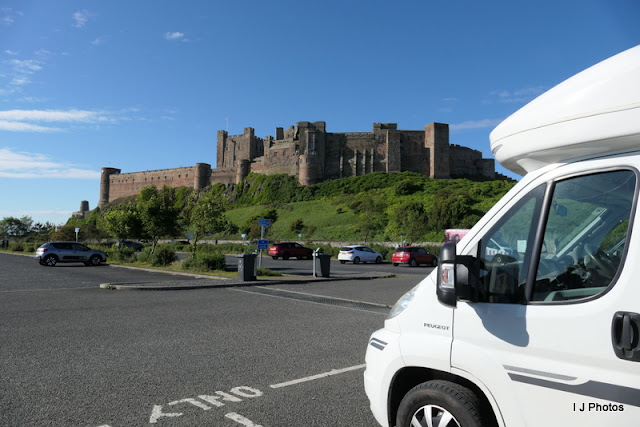There was very little planned for today, we had a day in hand before the trip to the Farne Island. Quite near to last night's campsite was a place called Hay Farm, it had a heavy horse breed called a Clydesdale and both thought it a good idea to visit. The farm was at a place called Ford and Etal, never heard of it but had loads of things to do there. You could visit the sawmill, railway, castle, and heavy horses, all within a few miles of each other. We had chosen the heavy horses, of course, having owned horses in the past it was a must see attraction. Unfortunately, we were too early for the carriage rides, which didn't start until July but instead, we happened at the right time to see a Clydesdale foal which had been born last Sunday. Still unnamed, a little filly but staff were considering either Iris or Ginny as a suitable name. It will be posted on their FB page so going to keep an eye on that. We even made the effort to walk down a muddy track to see the Clysdales in the fields. Armed with two bags of horse nuts as treats, they soon cantered over to see us.
So here are a good number of photos of the two hours spent at the farm.
 |
| Daisy and ? |
 |
| Teddy to the left and Merlin |
 |
| Dan |
 |
| And his name is Merlin just the same as our other narrow boat. |
Thousands of draught and pack animals succumbed to fatigue or diseases like mange. Others fell victim to the weapons of modern war.
The use of gas, artillery, mines, machine guns, mortars and tanks made the front a terrifying place for horses. In the early days of gas warfare, nose plugs were improvised for horses to help them survive. Later, special types of horse gas masks were developed.
Barbed wire was used in vast quantities to protect trenches. But thousands of horses got caught up in it and suffered severe injuries as they struggled to escape. Leg wounds suffered by horses often failed to heal or became infected, and the animals would have to be shot. Many horses also died as a result of the conditions at the front, of exhaustion, drowning, becoming mired in mud, and falling in shell holes. Other horses were captured after their riders were killed.
If you are ever in the Northumberland area I urge you to visit this place and support these endangered horses, not many Clydesdales are bred today. They are worth saving.
Nearby was Heatherslaw Light Railway. Well, it had to be done, we decided then and there to do the 6 mile loco trip to Etal Station. £8,50 each it was worth the 40-minute return. Plus at both ends the loco was turned on a small turntable by one of the guardsmen. It was great, we do so love a steam train trip.
Over an iron bridge crossing the River Till was Heatherslaw Corn Mill. Not even a 5 minute walk from the station, another place we decided to visit. There has been a mill on this site for over 700 years and dispite numerous floods, the last major one being 2016, it has continued working. Visitor's can now watch the milling process from the start to the end.
At Bamburgh Castle there was a long-term car park, we knew we could park but only if we had booked a bay. Yesterday Ian did just that and had an email come back to say bay 4 was ours but not to turn up before 6 pm. We arrived 5 minutes early only to find a camper in our spot. Awkward because now we had to ask those people to leave. They were from Germany and assumed, as they had scanned the QR code at the car park ticket machine, could use any bay. Anyway instead of leaving the car park, they moved to bay 1. Bad move because what should turn up but another motorhome having booked and paid for that. They had been informed by other motorhomes parked and told not to take any more of the bays unless booked but no, into bay two they went. Yep, you guessed it. That van turned up as well. He finally got the message and left!


















2 comments:
Wow, what fantastic places you visit, all the sorts of things that we like to enjoy as well.
Heavy horses are such gentle giants and a pleasure to be around, what lovely photos acompanying your blog too.
Ann xx
Thank you Ann Xxx
Post a Comment